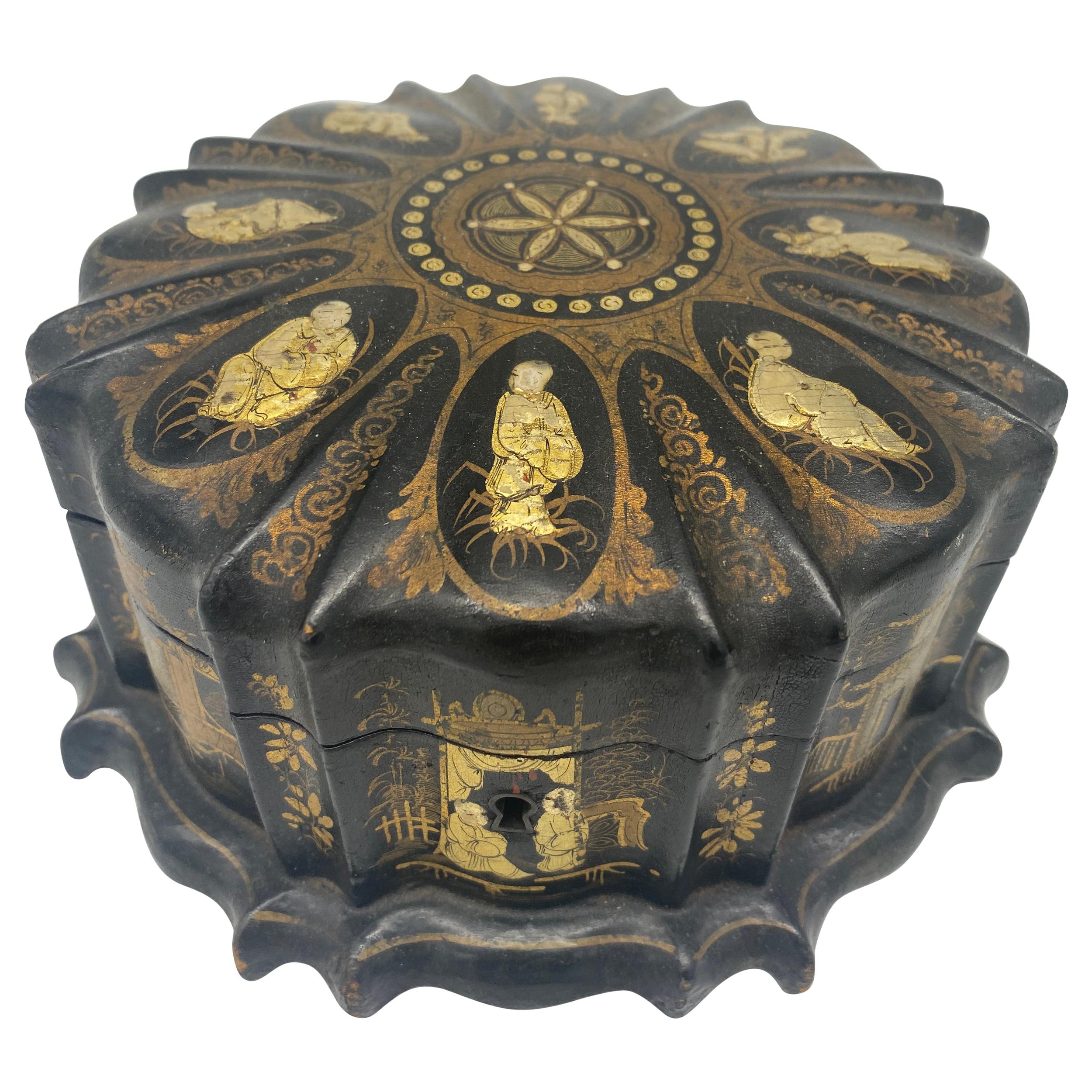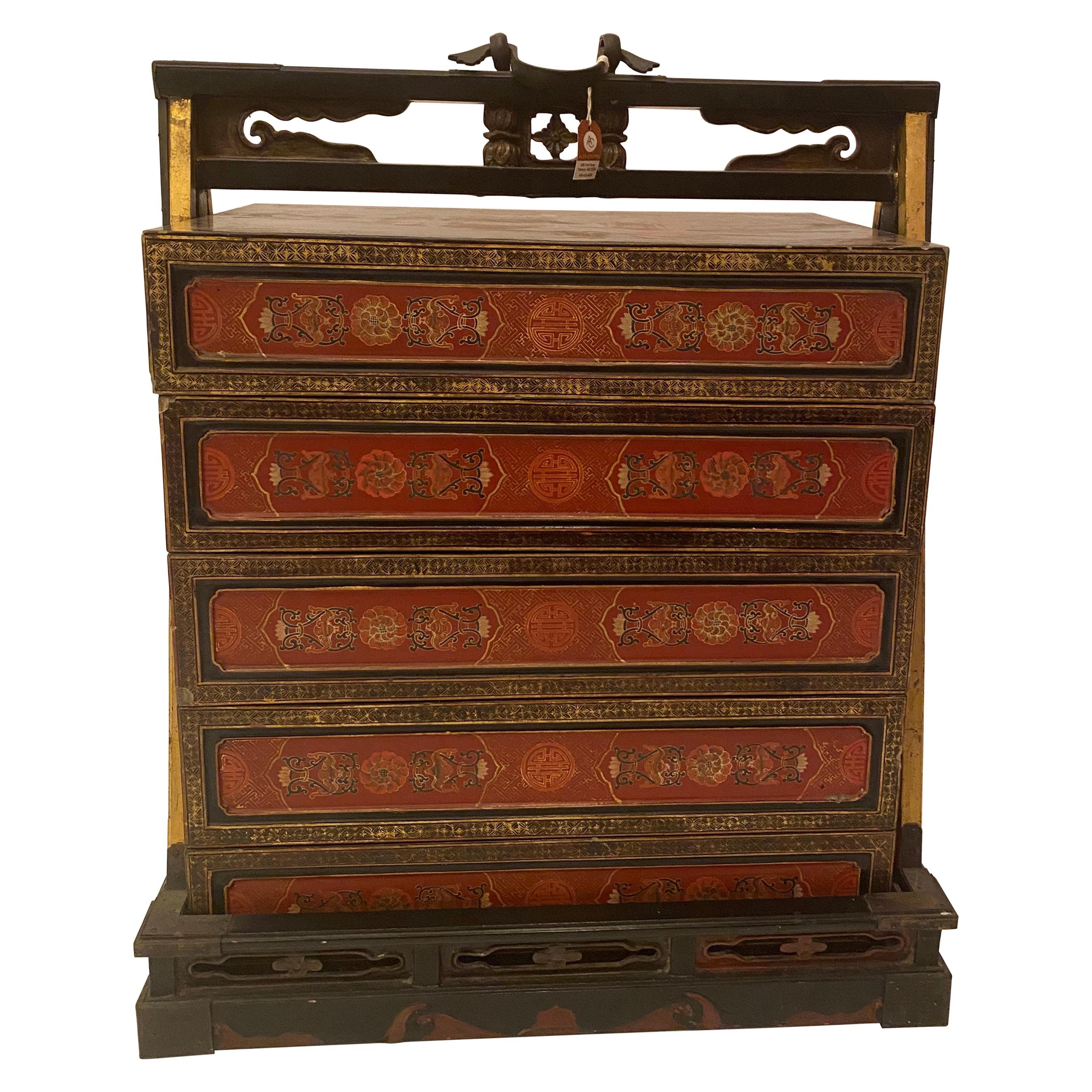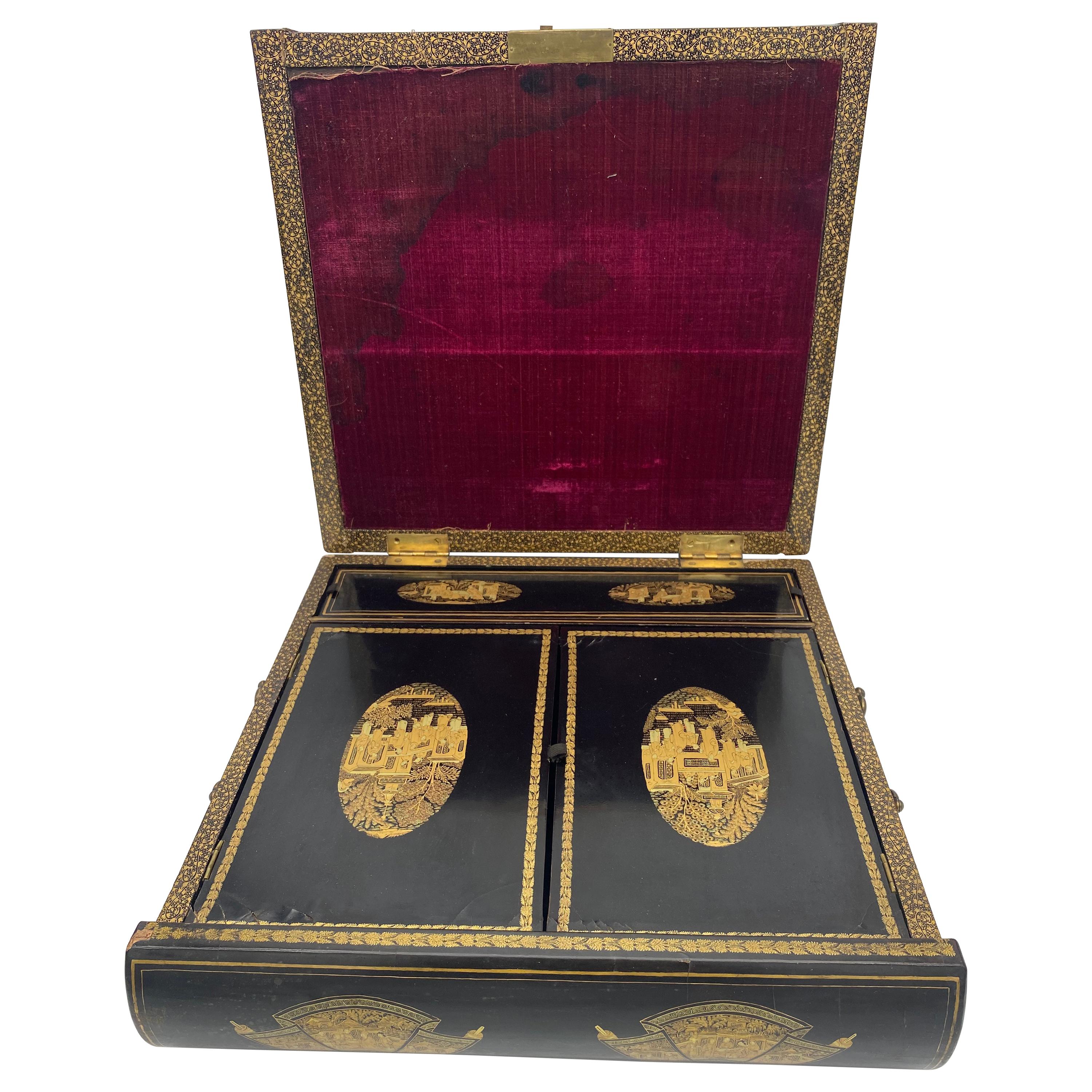Items Similar to 19th Century Chinese Lacquer Table Cabinet or Jewelry Box
Want more images or videos?
Request additional images or videos from the seller
1 of 13
19th Century Chinese Lacquer Table Cabinet or Jewelry Box
About the Item
A superbly decorative Cantonese black lacquer table or jewellery cabinet, exquisitely ornamented with Oriental figures and pagodas throughout.
China, Canton, Qing dynasty, mid-19th century.
Why we like it
A very decorative accent piece, useful for storage of small objects or jewellery.
Such luxurious items were popular in England during the height of fashion for oriental exoticism, called chinoiserie in Europe. Available to order through best luxury goods retailers of the era, such exquisite items as lacquerware, botanical gouaches or reverse-painted glass, were manufactured in Canton to be shipped to Britain.
Condition
Presented in very good antique condition, retaining its original decoration. Minor rubbing and touchups to finish, please see photographs.
Measurements
Height: 14.75 in / 37.5 cm
Width: 11.75 in / 30 cm
Depth: 6.75 in / 17 cm
- Dimensions:Height: 14.77 in (37.5 cm)Width: 11.82 in (30 cm)Depth: 6.7 in (17 cm)
- Style:Chinese Export (Of the Period)
- Materials and Techniques:
- Place of Origin:
- Period:
- Date of Manufacture:19th century
- Condition:Wear consistent with age and use. Minor fading. Presented in very good antique condition, retaining its original decoration. Minor rubbing and touchups to finish, please see photographs.
- Seller Location:Richmond, GB
- Reference Number:1stDibs: LU1781238279522
About the Seller
5.0
Platinum Seller
These expertly vetted sellers are 1stDibs' most experienced sellers and are rated highest by our customers.
Established in 2014
1stDibs seller since 2016
211 sales on 1stDibs
Typical response time: <1 hour
Associations
LAPADA - The Association of Arts & Antiques Dealers
- ShippingRetrieving quote...Ships From: Richmond, United Kingdom
- Return PolicyA return for this item may be initiated within 7 days of delivery.
More From This SellerView All
- 19th Century Chinoiserie Cabinet in Black Lacquer and Gilt DecorationLocated in Richmond, LondonExquisite early 19th century chinoiserie table cabinet in black lacquer and gilt decoration. Canton, circa 1830. Extremely rare to retain most of gilt decoration in such a pristine c...Category
Antique Early 19th Century Chinese Chinoiserie Lacquer
MaterialsLacquer
- Early 19th Century Chinese Reverse Glass PortraitLocated in Richmond, LondonA charming early 19th century Chinese export reverse glass portrait painting of a noble youth in state dress. Canton, circa 1820. Why we like it We love this delightful portrait for...Category
Antique Early 19th Century Chinese Chinoiserie Paintings and Screens
MaterialsGlass, Paint
- Pair of 19th Century Tapestry Pillows or CushionsLocated in Richmond, LondonA decorative pair of loose pillows or cushions, made of antique hand made needlework tapestry of floral design, with modern cotton backing and ruby / cream fringe edging. English, l...Category
Antique Late 19th Century English Victorian Pillows and Throws
MaterialsWool, Linen
- Large Antique Coromandel or Kuancai Lacquer Screen Six Panel Chinese ExportLocated in Richmond, LondonA superbly decorative six-panel lacquered 'Coromandel' screen, exquisitely carved and hand-painted with oriental figures, flowers and exotic beasts on a dark brown background, in the traditional 17th century manner. China, Canton, Qing dynasty, late 19th – early 20th century. Why we like it We like its impressive proportions which make it perfect for a feature wall, and the exquisite quality of decoration. The subtlety of colours lends a 'soft' look to the piece. The central motif depicts a scene set in the gardens of a Han dynasty palace, while the outer borders are decorated with the “one hundred antiques” motif interspersed with floral arrangements. In this regard, the present screen not only conveys auspicious meanings but also demonstrate the owner’s fine scholarly taste. History The term 'Coromandel', which is used to describe this particular type of lacquer technique (kuancai), is rather misleading. In the 18th century it was used commercially to indicate the place from which these objects were shipped to England through the East India Companies, and had no reference to China, the place of their origin. Similarly, Chinese painted wallpaper was often called 'India paper' in historic documants. The kuancai lacquer technique, literally meaning “cut out colour” and found almost exclusively on screens, emerged in the 16th century to serve the domestic market. The iconographic elements were carved through the built-up coats of dark lacquer and filled with pigments and gold. Seventeenth century examples usually consisted of twelve panels, and were often employed in entrance halls or as room dividers or windscreens for gardens and terraces. They were often commissioned as gifts and depicted court scenes, episodes from the world of the immortals, panoramic or landscape views and auspicious symbols. This type of lacquerware was flourishing during the reign of the Kangxi emperor (1662-1722) and saw a revival in the 19th century. Stylistically the present screen may be compared with the twelve-panel lacquer screen from the Kangxi period in the Victoria and Albert Museum illustrated by W. De Kesel and G. Dhont in Coromandel Lacquer Screens, ill. 23, pps 36-37. Such luxurious items were popular in England during the height of fashion for oriental exoticism, called chinoiserie in Europe. In the 20th century, Coromandel screens still remained a staple in the European interior design. Coco Chanel had a collection of 32 rare Coromandel screens, which she proudly displayed in her home at 31 Rue Cambom, Paris. She one...Category
Early 20th Century Chinese Chinese Export Screens and Room Dividers
MaterialsWood, Lacquer
- Antique 19th Century Regency Table LampBy Thomas HopeLocated in Richmond, LondonA very decorative Grand Tour vase after a design by Thomas Hope, mounted as table lamp, in porcelain with matte turquoise ground and glazed classical ornaments. English, early 19th c...Category
Antique Mid-19th Century English Regency Table Lamps
MaterialsPorcelain
- Pair of Antique Tapestry Pillows or Cushions, 19th CenturyLocated in Richmond, LondonA pair of decorative loose cushions made of antique handwoven tapestry of floral design, with modern linen backing and tassel fringe edging. French, late 19th – early 20th century. ...Category
Early 20th Century French Victorian Pillows and Throws
MaterialsWool
You May Also Like
- 19th Century Chinese Lacquer Jewelry BoxLocated in Brea, CA19th century Qing Dynasty Chinese lacquer jewelry box detailed with various genre scenes in gold detail. Pink silk lining, can be locked, does not ...Category
Antique 19th Century Chinese Qing Lacquer
MaterialsLacquer
- 19th Century Antique Hand Painted Chinese Lacquer Table Jewelry CabinetBy The Lacquer CompanyLocated in Brea, CA19th century antique hand painted Chinese lacquer jewelry cabinet with a pair of raised panel doors opening to five drawers with turned ivory...Category
Antique Late 19th Century Chinese Qing Lacquer
MaterialsLacquer
- 19th Century Chinese Lacquer BoxLocated in Brea, CA19th century Chinese lacquer box from the Qing Dynasty. Used for board games and golden by hand. In very good condition.Category
Antique 19th Century Chinese Qing Lacquer
MaterialsLacquer
- 19th Century Chinese Lacquer BoxLocated in Brea, CA19th century Chinese lacquer box from the Qing dynasty. Used as box for nails made of lacquered wood. Oriental scenes in golden. In ve...Category
Antique 19th Century Chinese Qing Lacquer
MaterialsLacquer
- 19th Century Large Chinese Lacquer Wedding or Travel BoxLocated in Brea, CA19th century large Chinese lacquer wedding or travel box from the Qing dynasty. Beautiful intricate designs all-over with images of ancient Chi...Category
Antique 19th Century Chinese Qing Lacquer
MaterialsLacquer
- 19th Century Chinese Lacquer Writing BoxLocated in Brea, CAA truly beautiful and amazing piece. From the early 19th century derived from the Qing Dynasty in China, this lacquered writing box is decorated wi...Category
Antique Early 19th Century Chinese Qing Lacquer
MaterialsLacquer
Recently Viewed
View AllMore Ways To Browse
Lacquered Glass
Lacquer Lacquer Cabinet
Black Lacquered Tables
Black Lacquer Table
Midcentury Black Lacquer
Mid Century Black Lacquer
Lacquered Table Mid Century
Asian Botanical
Black Lacquer And Glass
Black Lacquer Storage
Black Lacquer Cabinet
Asia Jewelry
Asian Jewellery
Asian Jewlery
Lacquered Mid Century Cabinet
Black Lacquer Storage Cabinet
Antique Table Cabinet
Lacquer Small Table





